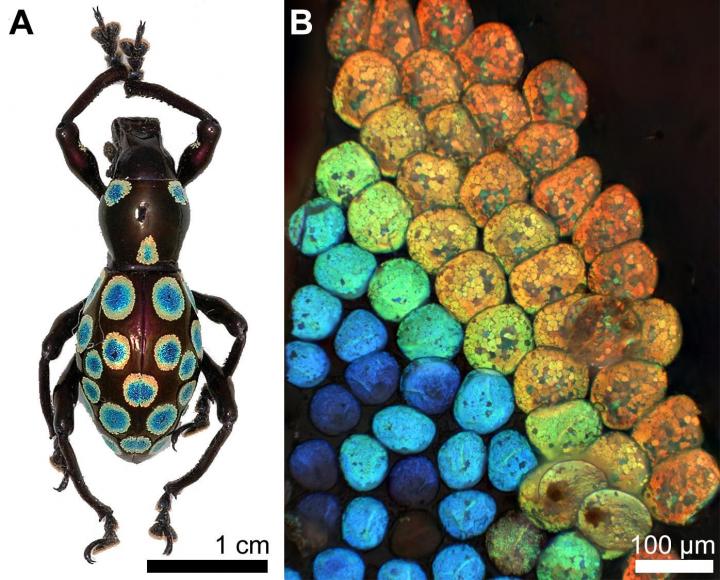
Natural Color-Generating Mechanism May Inspire Biophotonic Apps
Researchers from Yale-NUS College and the University of Fribourg have discovered a color-generation mechanism in nature, which, if harnessed, could potentially be used to create screen displays that project the same image when viewed from any angle, and even to reduce the signal loss in optical fibers.
Researchers at Yale-NUS examined the rainbow-colored patterns in the wing casings of a snout weevil from the Philippines, Pachyrrhynchus congestus pavonius, using high-energy x-rays, while a team from the University of Fribourg performed detailed scanning electron microscopy and optical modeling on the specimen.
While many insects have the ability to produce one or two colors, it is rare that a single insect can produce such a vast spectrum of colors as P.c. pavonius, also known as the rainbow weevil. Researchers want to understand the mechanism behind the natural formation of these color-generating structures, as current technology is unable to synthesize structures of this size.

Left: A photograph of the rainbow weevil, with the rainbow-colored spots on its thorax and elytra (wing casings). Right: A microscope image of the rim of a single rainbow spot, showing the different colors of individual scales. Courtesy of Dr. Bodo D. Wilts.
After examination, the researchers determined that the scales of the insect were composed of a 3D photonic crystalline structure made from chitin, the main ingredient in insect exoskeletons. They further discovered that the vibrant rainbow colors on this weevil’s scales are caused by two factors: the size of the crystal structure that makes up each scale, and the volume of chitin used to form the crystal structure. Larger scales have a larger crystalline structure and use a larger volume of chitin to reflect red light; smaller scales have a smaller crystalline structure and use a smaller volume of chitin to reflect blue light.
“The ability to produce these structures, which are able to provide a high color fidelity regardless of the angle you view it from, will have applications in any industry which deals with color production,” said Yale-NUS professor Vinodkumar Saranathan. "We can use these structures in cosmetics and other pigmentations to ensure high-fidelity hues, or in digital displays in your phone or tablet, which will allow you to view it from any angle and see the same true image without any color distortion. We can even use them to make reflective cladding for optical fibers to minimize signal loss during transmission."
According to Saranathan, the weevil’s ability to simultaneously control both size and volume factors to fine-tune the color produced has never before been shown in insects.
“It is different from the usual strategy employed by nature to produce various different hues on the same animal,” he said, “where the chitin structures are of fixed size and volume, and different colors are generated by orienting the structure at different angles, which reflects different wavelengths of light."
In this weevil, however, both the chitin volume fractions as well as the lattice parameters of the biologically self-assembled single diamond nanostructure are varied to achieve tuning of the structural colors across the visible light spectrum on a scale-by-scale basis. Uncovering the precise mechanism of color tuning employed by this weevil could support structural and developmental research on biophotonic nanostructures and lead to bioinspired applications.
The research was published in Small (doi: 10.1002/smll.201802328).
Published: September 2018